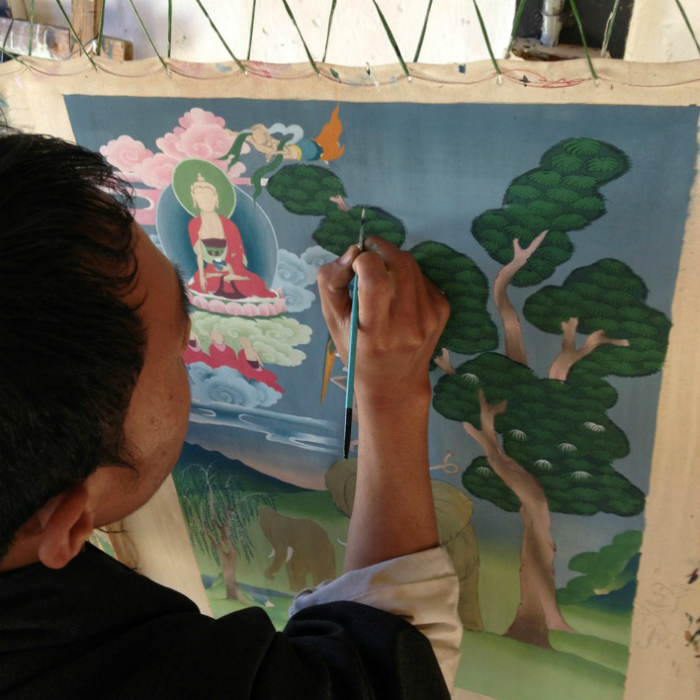Cultural Sustainability and Traditional Crafts in Bhutan

In the mountains of central Bhutan, a small group of craftspeople are struggling to sustain traditional practices that are disappearing as the remote Himalayan country becomes increasingly globalized.
The Choki Traditional Art School in Thimpu Province, Bhutan, offers free training in traditional Bhutanese crafts, such as weaving, wood carving, and painting, providing education to economically disadvantaged youth while revitalizing the fading cultural arts. Choki’s story is part of an important worldwide movement—a global narrative of communities and individuals working to preserve traditions and cultural practices that have great importance to them.
In earlier blog posts, we’ve discussed how traditions change over time, and how new generations often reinterpret cultural practices in order to strengthen identities and communities. This is evident on both a global and local scale in Bhutan. A full-time school with complete curriculum, Choki focuses on several traditional Bhutanese art forms and approaches education from practical and theoretical perspectives.

During their first two years, students study traditional rimo drawing, the foundation for future specialized study of more complex crafts. Additional practices covered include thanka (scroll) painting, patra (carving), thag-zo (weaving), and tshem-zo (embroidery). These skills are several of the zorig chusum, or “thirteen crafts,” Bhutan’s major traditional crafts. They represent hundreds of years of cultural practice, and many Bhutanese see their identity and history reflected in these crafts.
In Bhutan, painting religious scrolls, or thankas, is considered an act of spiritual devotion. These works of art were originally used as a visual aid for understanding Buddhist philosophy, belief, and practice. Painters had to purify themselves physically and spiritually, and then meditate on the piece they were about to create, before attempting to paint. These pieces are beautiful works of art as well as important tenets of the practice of Buddhism in Bhutan.
Educating painters is a tradition in itself: techniques are passed from lharip (master) to novice, though the practice of thanka painting is no longer as widespread as in previous generations. Painters work with naturally pigmented paints, made from soil and other locally sourced dyes, and paint on scrolls, religious altars, houses, religious statues, and cloth. The subject matter ranges from simple religious motifs to large mandalas and depictions of Buddhist deities.

Graduates from the Choki thanka program have founded their own painting businesses, contributed to the restoration of ancient monasteries, and painted new monasteries across Bhutan, keeping the artistic handicrafts of Bhutan alive.
Students at Choki can also study thag-zo (weaving), another endangered cultural practice. Woven textiles in Bhutan are highly valued, both materially and culturally. They express the social identity of the owner and carry symbolic and cultural associations.
In the past, textiles were used to pay taxes and as gifts to mark important events, such as religious ceremonies and life cycle events. However, due to increased access to imported synthetic dyes and yarn, very few weavers still practice all the traditional steps in the process.
The practice has been traditionally passed from mother to daughter, but, according to Choki principal Sonam Choki, “Many younger women now opt for other professions. There are far fewer successors to the present weavers than in the past. On top of that, there are now many cheap, mass-produced alternatives from across the border, which makes Bhutanese textiles very expensive as well as time-consuming to produce.” Choki graduates who study thag-zo sustain this culturally important traditional craft by learning all aspects of the process and becoming practioners themselves, producing high-quality woven goods.

Society in Bhutan has transformed considerably since these traditional crafts were widely practiced. Bhutan transitioned from a traditional monarchy to a democratically elected parliament in 2008, which coincided with the Bhutan: Land of the Thunder Dragon program at the Smithsonian Folklife Festival. Modern technology and tourism have opened Bhutan, historically a geographically and socially isolated region, to many outside influences, changing Bhutan physically and culturally.
Organizations like the Choki Traditional Arts School play an invaluable role in preserving and rejuvenating traditional arts and crafts before these forms of cultural identity are forgotten.
Choki’s practice of cultural stewardship and education aligns very closely with the Center for Folklife and Cultural Heritage’s mission, which envisions a world that recognizes traditional artistry, diversity, and cultural participation as critical to the future of humanity.
James Mayer serves as the assistant to the director and assists with public affairs at the Center for Folklife and Cultural Heritage.

